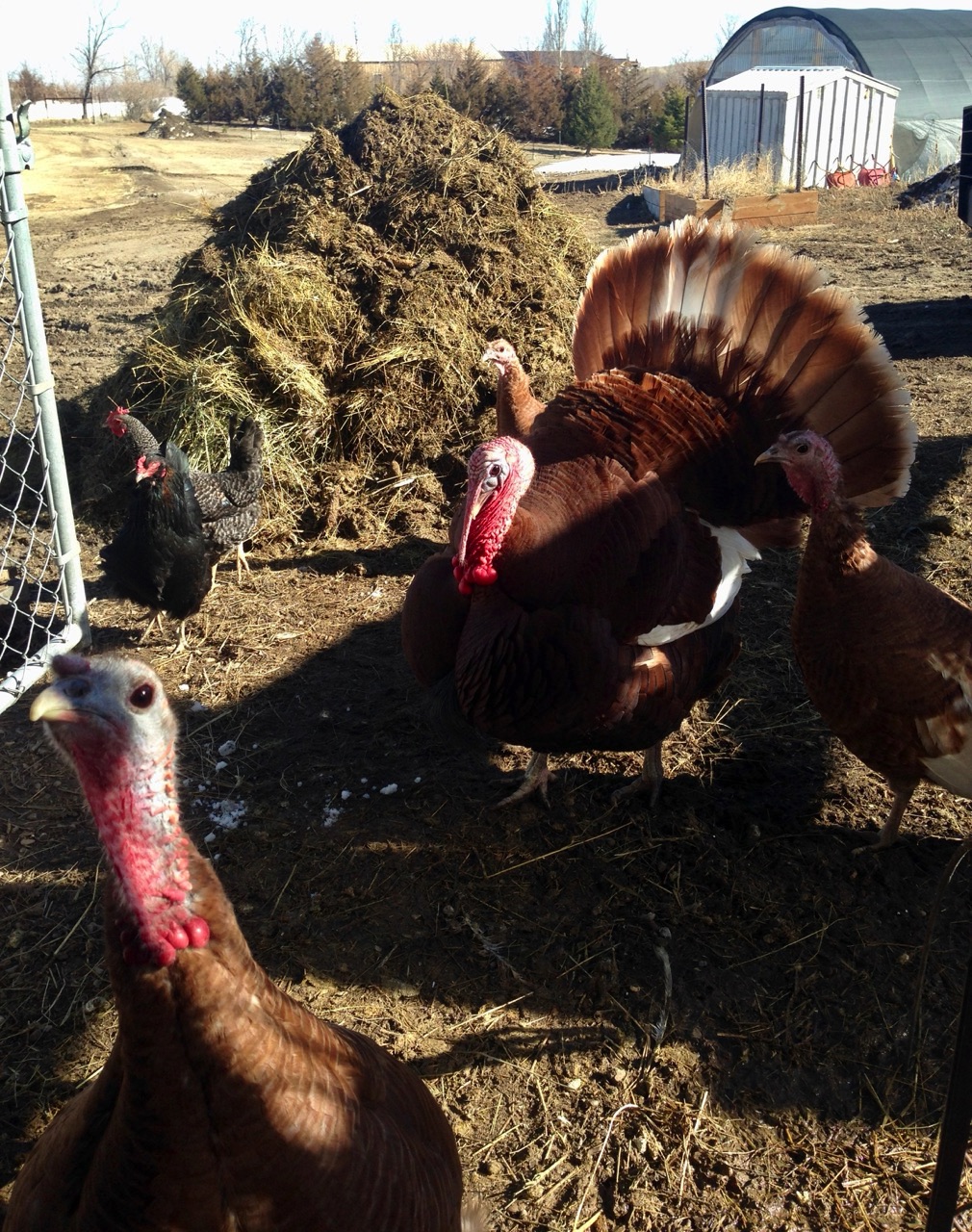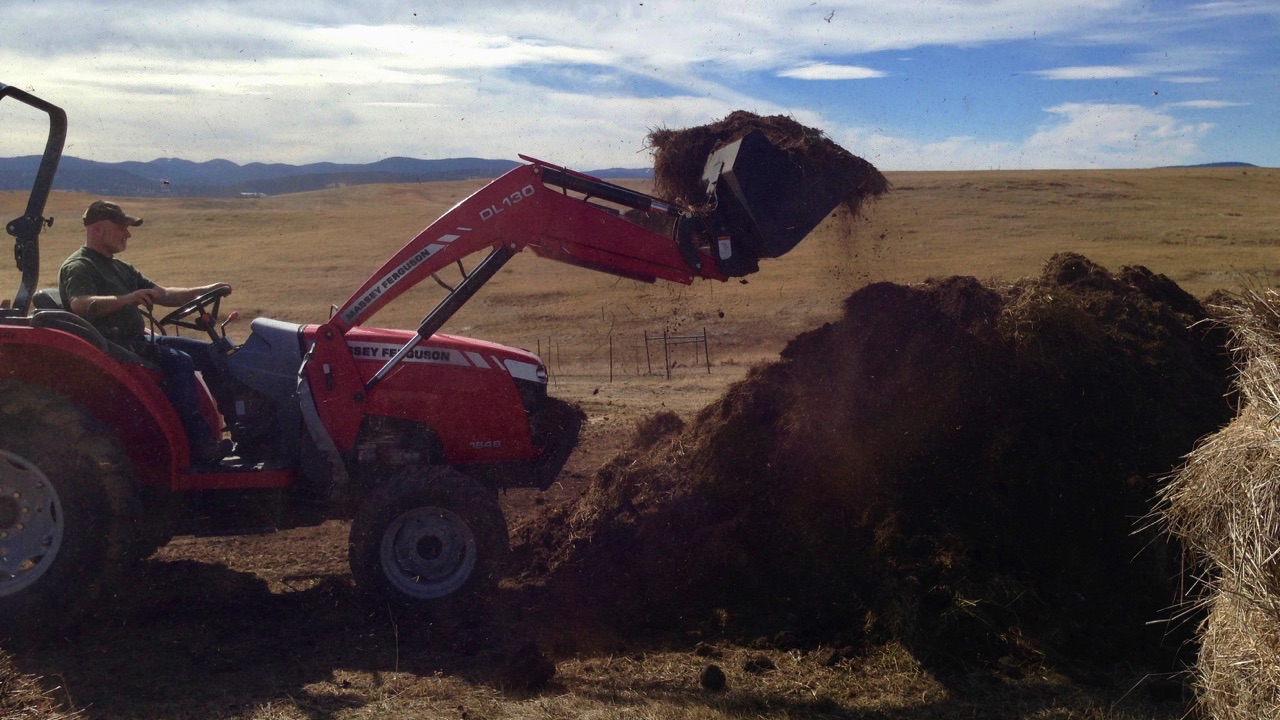We Sell Compost!
We make and sell compost on our farm. We sell it by the tractor bucket (approximately a cubic yard) for $50, or by the five-gallon bucket for $3.
We make and sell compost on our farm. We sell it by the tractor bucket (approximately a cubic yard) for $50, or by the five-gallon bucket for $3.
Soil fertility is extremely important to us at Bear Butte Gardens. We utilize a variety of natural organic methods to maximize soil nutrition, such as: rotating crops, using cover crops, using companion crops, allowing gardens to rest (fallow), and applying compost to gardens. These natural and organic methods are how Mother Nature has been enriching the soil for thousands of years.
Organic matter that has been decomposed in a process called composting. This process recycles various organic materials otherwise regarded as waste products and produces a soil conditioner (the compost). Compost is rich in nutrients. It is used, for example, in gardens, landscaping, horticulture, urban agriculture, and organic farming. The compost itself is beneficial for the land in many ways, including as a soil conditioner, a fertilizer, the addition of vital humus or humic acids, and as a natural pesticide for soil. In ecosystems, compost is useful for erosion control, land and stream reclamation, wetland construction, and landfill cover (see compost uses). At the simplest level, the process of composting requires making a heap of wet organic matter (also called green waste), such as leaves, grass, and food scraps, and waiting for the materials to break down into humus after months. However, composting also can take place as a multi-step, closely monitored process with measured inputs of water, air, and carbon- and nitrogen-rich materials. The decomposition process is aided by shredding the plant matter, adding water, and ensuring proper aeration by regularly turning the mixture when open piles or "windrows" are used. fungi, earthworms, and other detritivores further break up the material. Bacteria requiring oxygen to function (aerobic bacteria) and fungi manage the chemical process by converting the inputs into heat, carbon dioxide, and ammonium.

As a USDA Organic Certified farm, we follow all USDA Organic Certified regulations for compost. We also follow the Food Safety Modernization Act (FSMA) guidelines for compost.
I would like to point out a fine detail about how the USDA Organic inspecting agencies view compost. The term "compost" and the term "raw aged manure" are two similar, but different things. Both can be used in a garden. However, true finished compost can be applied to a garden right away. Raw manure can also be applied to a garden, but it must be applied 120 days before the harvest of a product (or 90 days before the harvest of a product whose edible portion does not have direct contact with the soil surface or soil particles) -- thus the "aging" part. The USDA Organic regulations about compost are straightforward, and we follow all of them. However, it is extremely difficult to measure and document every last detail to the satisfaction of the organic inspecting agencies -- to the result that very few farms can obtain such approval. The regulations about aged raw manure are much less stringent. So, what most organic farms do, is follow the regulations for composting, but also wait 90 or 120 days to apply it to a garden. This exceeds the regulations. This is also what we do at Bear Butte Gardens. For the content of this web page, the term "compost" will be used. However, within the context of an organic inspection, what we do is apply "aged raw manure" (that has been composted) to our gardens -- following the 90/120-day regulation.

Input Materials
A composting process requires:
1) carbon-based material
2) nitrogen-based material
3) water
4) oxygen
For the carbon-based material, we mainly use our own, organic certified grass hay. We will also add various garden waste such as the unused plant stalks, leaves, and vines -- after harvesting the vegetable/fruit crops. At the scale of compost we process in a batch, we usually start with several tons of grass hay.
For the nitrogen-based material, we mainly use manure and bedding from our poultry (chickens and turkeys) and livestock (cattle, sheep, and goats).
For the water, we can generally rely on rain and snow. However, if we experience very dry conditions, then water must be added.
For the oxygen, we turn the compost pile with a tractor and loader -- we move the pile from here to there, and then back again, over and over, as required (details below). This introduces the appropriate oxygen required for an aerobic process. A smaller compost pile could be turned by hand, with a pitchfork or shovel, or similar.

Material Ratios
We combine a lot of carbon-based material, with a little nitrogen-based material -- in a ratio of about 25:1. This ratio is in line with organic regulations. If there is too much nitrogen, then it will stink (the first few days might be a little stinky no matter what -- but should get better after a few days if the ratio is correct). Also, if there is too much nitrogen, it will tend to heat up too much and become a bit difficult to control. If there is too much carbon, then it will not heat up enough. Either of these problems can be fixed by adding more of the appropriate material.
Moisture content should be between 40% and 65%. To check the moisture level, dig into the pile at least one foot, pick up a handful of compost, and squeeze. It should at least feel moist. If you can squeeze out just a few drops of liquid, that is about perfect. If it is dripping wet, then that might be a bit much.
If the materials are mixed in the proper ratio, and water & oxygen are present, then a biological reaction will occur. The process will generate heat.

Temperature
Organic regulations require the pile to maintain a temperature between 131 and 170 degrees Fahrenheit for 15 consecutive days. These regulations also require the pile to be turned a minimum of five times within that time.
The process of turning the pile has a mixed effect on the temperature. At first (almost immediately) the temperature will decrease. However, if the material ratios are correct, it will soon start to heat up.
We use a three-foot compost thermometer to get accurate temperature readings.
If all goes well, the compost pile will be hot enough to kill pathogens and weed seeds, but not so hot as to kill other beneficial microorganisms. If a compost pile remains hot (above 131 degrees F) for long periods (e.g. not turning the pile frequently enough), the lack of oxygen kills beneficial fungi, protozoa, and nematodes that help retain key nutrients.
It is a bit of an art. The goal is to have enough heat to kill the bad things, but not so much heat to kill all the good stuff. Knowing the science will help make the correct decisions.

Completion - The process is complete when the pile returns to ambient temperature levels.
Note: if you apply "hot" compost (5 degrees above ambient temperature) to a plant, it could harm the plant.